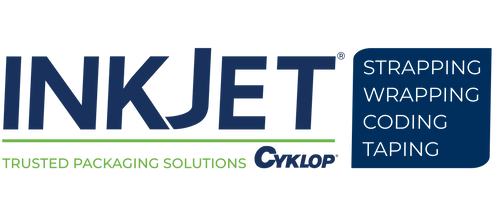How Does an Inkjet Printer Work? CIJ and TIJ Systems Explained
Inkjet printers have existed in various forms since the 1950s when continuous inkjet (CIJ) printers first became available to the public. Built for production line printing, CIJ printers are resilient machines that are fast enough to mark thousands of products a day with traceable codes, machine-scannable markings, and important information.
In addition to continuous inkjet printers, there is a wide variety of drop-on-demand (DOD) inkjet technologies as well. These printers differ from CIJ printers in that they do not create a “continuous” flow of ink droplets for uninterrupted marking. Instead, they only generate droplets when actively completing an application—hence, “drops on demand.”
The most popular type of DOD inkjet printer is the thermal inkjet (TIJ) printer. In industrial contexts, thermal inkjet printers are compact devices that are used for production line printing and handheld marking applications. Home and office printers also use TIJ technology to create documents.
But, how does an inkjet printer work? Below, we examine both continuous and thermal inkjet printer operating principles to explain how these machines create markings.
How Does an Inkjet Printer Work? Continuous Inkjet Printers Explained
Continuous inkjet printers are built to operate for up to 24 hours per day without breaks or interruptions. Many CIJ models, including InkJet, Inc.’s DuraCode Touchscreen and DuraCode Pigment, can print on production lines moving at speeds of over 300 m/min and resist potentially disruptive elements such as dust, high moisture, extreme temperatures, and more. Thanks to these capabilities, CIJ printers are often utilized by manufacturers and packaging companies to complete demanding product marking applications.
The term “continuous inkjet printer” stems from how these printers internally circulate a continuous flow of ink. In the graphic above, you can see a diagram of the CIJ circulation principle in action. The bottom half of the graphic shows the controller (i.e., where the ink is stored, mixed, and pressurized), while the top half shows the printhead (i.e., where the printer expels the ink toward a substrate).
Here’s a breakdown of what the labeled controller components are doing in the diagram above:
- Two chipped cartridges: These two bottles supply the fluids that will be used to print on the substrates. One cartridge contains the ink itself, while the other contains solvent or make-up. The “chip” refers to a small printed circuit board installed into each cartridge that enables printer compatibility
- Main reservoir: The two chipped cartridges feed into the main reservoir where they combine into a single printable mixture.
- Pressurizing pump: This pump is positioned next to the main reservoir and pressurizes the ink mixture to feed it toward the printhead.
- Decompression valve: The final element in the controller, the decompression valve makes necessary ink pressure adjustments to the mixture before it arrives at the printhead.
Once the ink mixture reaches the printhead, the following components complete the marking process and funnel the remaining ink back to the reservoir:
- Piezoelectric element: The piezoelectric element oscillates the ink stream with vibrations to form distinct droplets.
- Nozzle: The nozzle propels the droplets toward the substrate.
- Charging electrode plate: As the droplets are propelled through the nozzle, they are given an electric charge by the electrode plate. The charge enables the droplets to be directed by the deflecting electrode plate.
- Deflecting electrode plate: This second electrode plate creates a magnetic field that differentiates which droplets should be propelled toward the substrate and which droplets should be rerouted back toward the main tank.
- Gutter: The gutter collects the unneeded ink particles and reroutes them back to the tank, ensuring that the ink flow is continuous.
Popular CIJ Printer Applications
In addition to being fast, reliable, and accurate, CIJ printers are compatible with a wide range of materials, including both porous and non-porous substrates. CIJ printers are also capable of printing on flat and curved surfaces, making them a great fit for printing on an array of packaging forms.
As long as you use the appropriate ink formula, a CIJ printer will be able to print on the following substrates:
- Cardboard packaging
- Corrugated boxes
- Paperboard cartons
- Metal sheets and foil
- Wood
- Plastic bags
- Aluminum cans, foil, and bottles
- Glass bottles
- Rigid plastic
- Plastic PVC pipe
- Tetra Pak® and aseptic packaging
- Flexible packaging
- Shrinkwrap and flexible film
- Metal pipes
- Rubber parts and products
- Plastic bottles
How Does an Inkjet Printer Work? Thermal Inkjet Printers Explained
Compared to continuous inkjet printers, thermal inkjet printers are smaller machines with fewer parts. Weighing only 5-10 pounds, TIJ printers are compact machines that are most often used for production line printing but are available as handheld models for mobile marking as well.
Instead of using pressurizing pumps and vibrations to create and propel ink drops, TIJ printers use heating elements. TIJ printers source liquid ink from small disposable cartridges. The heating elements raise the temperature of the ink to create markings through a process called “drop ejection.”
Here’s how drop ejection works:
- A heater heats the ink: The ink is sent from the cartridge toward a chamber where electronic resistors heat it at a rate of 1,800,032° F (1,000,000° C) per second.
- Ink vaporization generates a bubble: After the ink has reached a temperature of 644°F/340°C, the effect of vaporization generates a bubble.
- The bubble forces ink out of the nozzle: As the bubble expands, it propels the ink from the chamber and out of the nozzle.
- Bubble collapse causes the droplet to break off: As the ink droplet breaks away from the nozzle and lands on the substrate, the bubble collapses and creates a vacuum effect. The vacuum pulls more ink into the chamber, repeating the process.
Popular TIJ Printer Applications
TIJ printers are known for their accessible price points, intuitive operation, easy maintenance, and excellent code quality. Although most TIJ printers don’t offer the same printing speed as CIJ printers, they can create more intricate graphics, higher-quality codes, and larger markings. Moreover, higher-end TIJ models like the Anser X1 offer printing speeds of around 300 m/min, matching the specs of many CIJ printers.
Not all TIJ printers are compatible with both porous and non-porous materials, but many models are. Accordingly, you need to be diligent when selecting a TIJ printer to ensure that you select a model that is compatible with your substrates. With the right printer and ink combination, you will be able to mark primary and secondary packaging with:
- Alphanumeric messages
- Shipping information
- Traceable codes
- Machine-scannable markings
- Graphics and company logos
Need a New Inkjet Printer? Contact InkJet, Inc. Today
InkJet, Inc. is your source for industrial inkjet printing hardware and fluids. For more than 30 years, we have been formulating inks and creating printing solutions for companies of all sizes and specialties. Whether you are looking for a high-speed CIJ, a cost-effective TIJ, a versatile laser marking system, or any supplies for these machines, InkJet, Inc. can help you find it. Call us today to learn more.
For more information about how inkjet printers work, contact InkJet, Inc. online or call 1(800) 280-3245.



